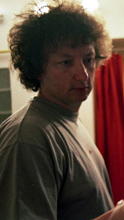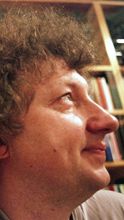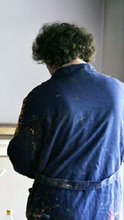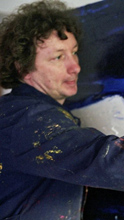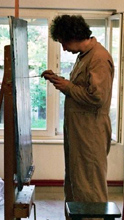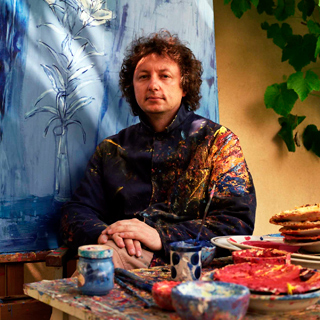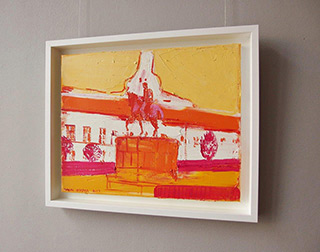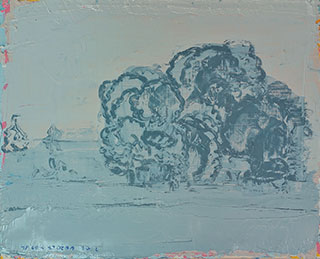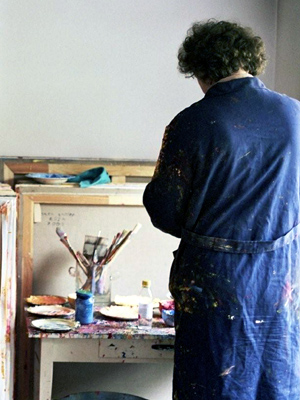I come from Wloszczowa, a small town near Czestochowa
When asked about the beginnings of their work, artists usually talk about their childhood, about how they had learned to draw before they learned to speak. What was it like in your case?
Different. I didn’t want to be a painter but a historian, and ideally, a national hero. If I drew anything in my childhood it was tanks, aeroplanes, knights and my favourite hussars, the 15-18th century cavalry. I was an expert on the greatest battles fought by Polish troops, and their defeats hurt me so much that even if a particular battle had really been lost, my knights won it on paper. I read lots and lots of historical books, I re-lived Potop and Pan Wolodyjowski (The Flood and Mr Wolodyjowski, historical novels by Henryk Sienkiewicz) in my dreams. Even then I was already interested in paintings by Piotr Michalowski, whom I still consider one of our best painters. I got to know his drawings of cavalrymen and his studies for Somosierra very early. Patriotic traditions were also alive in our home; my grandfather, a wartime partisan, would tell me war stories to send me to sleep, and it was he who instilled in me the conviction that a Pole is a knight who is never defeated. It is so deeply-rooted in me that when our national football team loses yet another international match it nearly makes me ill.
Going back to history, were the drawings of hussars the end of that?
On leaving secondary school I took exams to the history department of Warsaw University. Sadly, I was not admitted. Having no idea what to do with myself, I tried the exams to the arts department of a college of education and succeeded. After three years I passed the exams to the Academy of Fine Arts in Warsaw and was no longer in doubt as to what I was going to do.
But you transferred the knights, the firemen, the planes, all the paraphernalia of a teenage imagination into the world of your paintings?
I transferred them just as I transferred myself. It was inevitable. At the same time, I developed, learning new things. For example - that to draw is not to create a likeness. Say you want to show someone singing: it is not enough to paint an open mouth; you have to make the paper sing. Maciej Urbaniec, my poster design professor, did not teach us painting methods, but thinking and economy of expression. Those are the most important things for a poster painter.
I often think about economy when I look at your huge paintings with a single figure in each: a cyclist, an angel or a girl on a swing. They are very powerful, condensed beings.
That’s because I come from Wloszczowa, a small town near Czestochowa, where if anything appeared, it really appeared: if a car passed, everyone saw it; a woman going shopping on her bicycle escaped no one’s attention, let alone a horse pulling a cart full of coal. A horse - now that was an experience! In a small town seemingly trivial things gain importance, they become events.
Was the religious worship of Jasna Góra part of your formation
I was deeply moved by all the pilgrimages to Jasna Góra. I would spend hours staring at the people who walked like an army formed into regiments. But what I liked best were the processions with banners, which often recur in my paintings. I was impressed by the ritual, by the division of roles and the uniforms: the priest in a cassock, altar boys in surplices, girls in white dresses strewing flowers on the ground. Those were unique spectacles, with pomp, where everyone had their precisely allocated place and role.
What about angels, do they come from the Czestochowa repertoire too?
That’s rather internal repertoire. An angel is an ideal being and my favourite hero. His force is effortless, he can be here and there at the same time, he knows everything and, on top of all that, he can fly! I paint angels so that there will be more of them in the world. I contribute to the sum total of good in the world in this way. Well, jokes aside, I do believe in my own guardian angel. I often think he is my father, who was a sculptor. Even the name fits, as I have always perceived him as a Michaelangelo, only working in sandstone instead of marble. From a perspective, I can see how many misfortunes I avoided thanks to his discreet care. I was just about to put my foot on the verge of a chasm, and my angel would come up, say something and lead me in a different direction. Angels are very real creatures to me.
Is that why you paint them so thickly, with almost relief-like texture?
If it were feasible, I would sculpt in blocks of paint instead of painting. I’m not satisfied with the illusion of a third dimension which can be shown in a painting. I apply paint so thickly, I fray it, roll it into noodles, because I want the picture to stick out even a little a bit. I am, if I may say so, a tactile kind of person, and that form of contact tells me most about the world. Rough, smooth, warm, cold, pointed, oval - that is the most important information about objects, which the eye can only guess at. I know this is a strange creed for a painter.
Maybe it is this sensual approach to matter that has led you to making stencils and cut-outs?
That was rather through necessity than any particular kind of sensitivity. When I returned to Czestochowa after my studies I wanted to make posters. Stencils turned out to be the only method of obtaining several hundred large-sized copies that was cheap and effective enough. When a stencil was sprayed in different colours when making the copies, it turned into a coloured cut-out. I thought that it would be a sad waste to throw out such used stencils, that pasted onto a contrasting background they make an interesting whole. Then I got to like those cut-outs so much that I started making them as independent works.
You had to learn a new technique. One thinks differently when cutting things out than when holding a brush!
And that’s what I like. A brush is unpredictable, you never control it fully. And the cut-outs - I use a lancet to make them; everything depends on me. The emotions are completely different and so is the end result. Besides, it reminds me of modelling, which I have adored since I was a child.
Your friends say that your room looks like a model of Heathrow airport. How long have you been making model aeroplanes?
I put together the first one when I was eight. Now I’ve got four hundred. Fat Dakotas DC 3, elegant Lockheed Constellations - they are strong and good, like everything that flies. Angels, balloons, aeroplanes belong to the element of air, which I’m closest to. Belief in the benevolent strength of whatever floats or hovers in the air is some kind of archetype which I evidently submit to.
Your artistic world is full of archetypes. The immortal heroes from Greek mythology seem to have disappeared recently. Have you said farewell to Iason and Theseus?
I stopped painting men, not mythology, because I prefer to surround myself with women. From Greek mythology, Ariadne still keeps returning from time to time, but most of the heroines are contemporary. My wife Ela is an indefatigable cyclist, the girl on a swing is my daughter, the girls with drums and rifles are my students.
Are those attributes accidental or authentic?
Authentic - not literal, but authentic. The girl with a drum is frightfully talkative, and she always speaks like a herald announcing something very important. The one with a rifle has told me about her loves, in which she is stronger than the men and actually she would gladly get rid of them... I have also painted her with a sword, with which she pierces red hearts. The one on roller-skates is my wife’s colleague. I always used to see her in impeccable suits and when I saw her rushing about on roller-skates in a a track suit I was flabbergasted. The best pictures come from being surprised. I hope there are still many before me.


